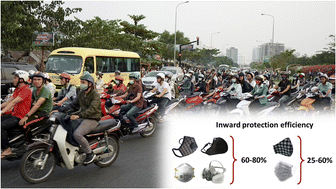Effectiveness of wearing face masks against traffic particles on the streets of Ho Chi Minh City, Vietnam†
Abstract
Motorbikes are by far the dominant mode of transportation in Ho Chi Minh City (HCMC). They solve mobility problems but represent a health risk since riders are directly exposed to noxious exhaust fumes. Hence, face masks emerge as a solution to reduce exposure to harmful particles. The manufacturers of these masks report that they can significantly reduce particle exposure on roads with vehicular traffic. Such reports are usually based on laboratory assessments, with limited data from field experiments. To evaluate the performance of the masks commonly worn by HCMC commuters under quasi-real exposure conditions, we tested the total inward leakage of particles (i.e., including penetration through the filter media, and leaks from the face seal and exhalation valve if the mask is equipped with one) of six representative masks mounted on manikins at the curbside of two busy roads during high traffic time periods. Several particle metrics, including mass and number concentrations, active surface area, and abundances of equivalent black carbon and particle-bound polycyclic aromatic hydrocarbons, were measured to determine the protection level provided by masks against distinct types of particles. As part of this study, through a set of measurements using the same instrumentation we found that commuters are exposed to a mix of freshly emitted particles and aged particles, including contributions from sources other than motorbike exhaust, such as trash burning and street food stalls. Ultrafine particles, especially those in the nucleation mode (<50 nm), turned out to be the dominant fraction in terms of number concentration. This study focused its evaluation on these particles. We found that no mask can completely remove all particles under practical conditions. It is largely due to inappropriate mask fitting. Performance efficiency of 60–80% was achieved by an N95 respirator, a reusable valved filtering mask, and a locally manufactured carbon-layer sandwiched mask. Surgical and cloth masks achieved efficiencies of 25–60%. The results show that any face mask provides some level of protection. Efforts should be made to provide end users with practical information on the effectiveness of masks under real conditions, and informing on how to best fit each mask to increase effectiveness.

- This article is part of the themed collection: Impacts of air quality on human health - Topic Highlight


 Please wait while we load your content...
Please wait while we load your content...